I was attacked in the Congo…by a monkey.
The Tale of Two Congos
Country #133 for me was The Democratic Republic of The Congo, hereinafter referred to as the “DRC.” They say the visa for DRC can be tricky: it involves a signed and notarized invitation letter before you can even apply. I cover all of this in my previous blog: Republic of Congo; Yes, there are indeed two Congos. I also cover in detail how I entered the country, crossing the Congo River by boat from Brazzaville, ROC over to Kinshasa, DRC. You can find all that in my ROC blog.
As I detailed in the ROC article, crossing the river into DRC was a little cumbersome, but thankfully went off without a hitch. No sooner did I step of the boat on the DRC side, did I see my guide Jeremie holding a paper sign with my name on it. I was glad, because the dock was a mad house. Seemed like there was a hundred people all standing on a tiny, 10×10 platform. Jeremie ushered me right through and all the way out of the madness, as we headed down a concrete gangway with what looked like holding cages on each side. Leaving this “beach” was 100 times faster than departing from the Brazzaville port, just seven minutes across the river. Before I knew it, we were heading out onto the streets of Kinshasa in an air-conditioned silver Toyota 4-Runner. Mission accomplished, I’d successfully crossed the river and entered the DRC.


Supersize Me
My first impression of Kinshasa was just how enormous the city was. If Brazzaville was Amarillo, Kinshasa was Dallas. This was a huge city! It was now early afternoon as we rolled down the main drag: the eight-lane Boulvard du 30 Juin. I wondered how two capital cities so close together differed so drastically in size. Fun fact: Brazzaville (ROC) and Kinshasa (DRC) are the world’s closest capital cities, less than a mile apart. So I couldn’t figure out why the two were so drastically different. What kind of businesses and economies were flourishing in Kinshasa that weren’t in Brazzaville. Maybe it was simply the difference in population. Whatever the case, these sister cities did not look like they were related one bit.
I was also amazed at how traffic flowed in Kinshasa, despite the absence of traffic lights. For example, how Jeremie (and others) were able to make a left turn and cut through four lanes of oncoming traffic unscathed amazed me. Back in the US, God forbid you turn in front of someone, and it’s like you just stole their firstborn. In Africa, everyone goes wherever they can, however they can, and diving straight into a mass of moving traffic is considered normal.

Monkey Business
After a quick stop to check in and freshen up at the Hotel Sultani, it was off to see the bonobos. Bonobos are one of four breeds of monkeys, most closely related to humans. Along with the chimpanzee, the gorilla and the orangutan, the physical, emotional and intelligence qualities of bonobos are the closest to man as the other three mentioned. The ride was long, the traffic was bad and the roads were brutal, but about 90 minutes later we’d arrived at the Lola Ya Bonobo park.
Admission to the park was just $10USD. I scoffed in disgust remembering one of the other companies quoted me $432 to visit the park. Insane! In my previous ROC blog, I detailed just how expensive booking tours in both Congos are. It’s the definition of highway robbery, and I assume it’s because any traveler crazy enough to visit the Congos as a tourist, is crazy enough to pay those exorbitant prices. I’d shopped around and chose Jeffrey Travels who seemed much more realistic, but still pricey. My complete DRC two-day tour turned out to be $685 which didn’t include the river crossing.
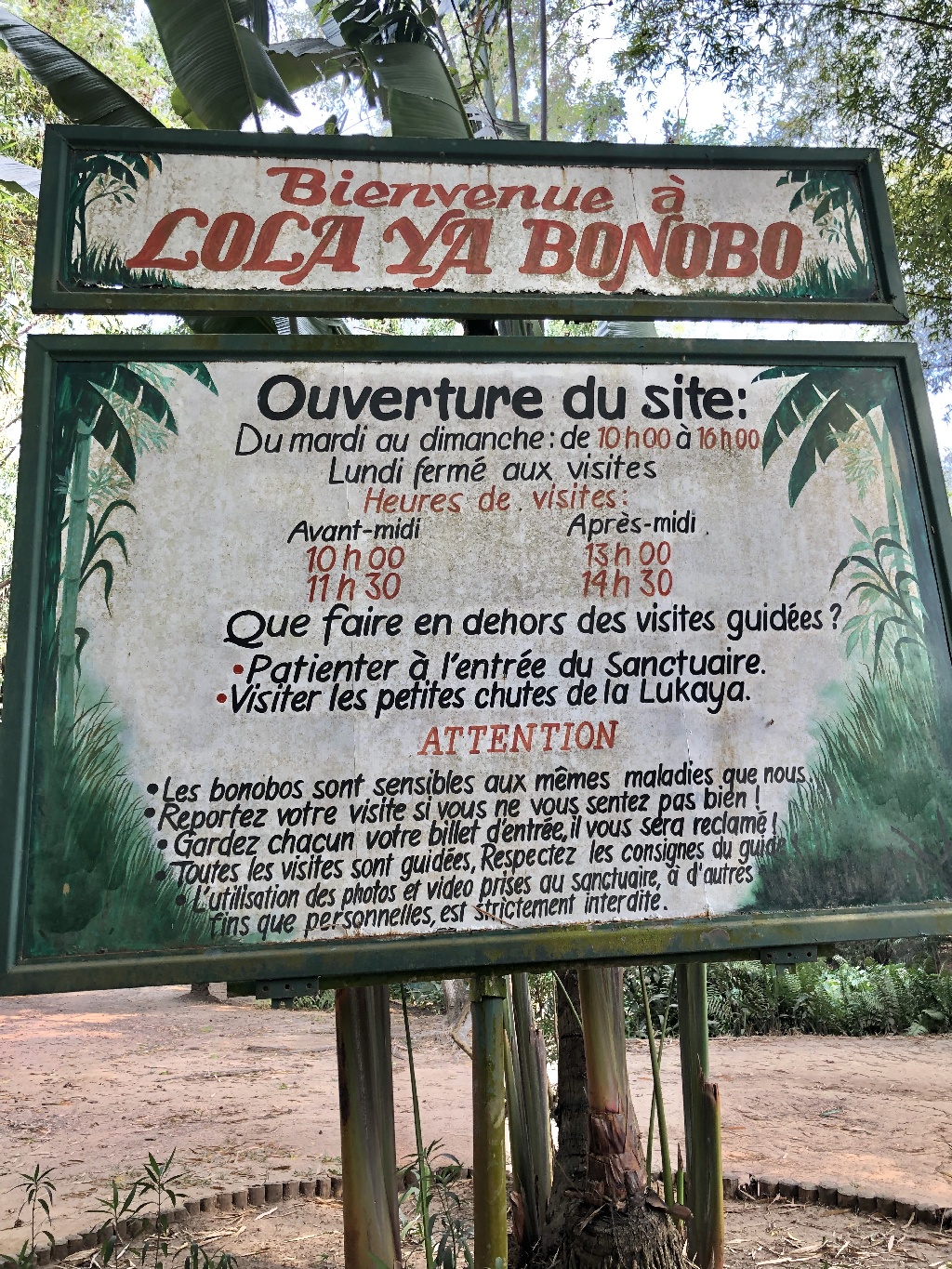

No Monkey Left Behind
The first area we visited at the park was an area where the baby bonobo orphans were being fed. Our guide explained that these little guys were left to fend for themselves after their parents were poached. So sad! Each baby bonobo actually has an adopted human mother to care for it, including feeding, bathing, etc. I thought that was absolutely awesome and enjoyed watching half a dozen of the babies from behind a big, clear barrier. I’d hoped to get a little closer to these cuties, but I’d soon learn that they were much too wild to risk any accidents with tourists.

The Green Lagoon
After we were done visiting with the babies, the small group I was part of walked for about ten minutes, passing over 20 full-grown and “wild” bonobos, frolicking about on the other side of a big lagoon. The guide explained that the monkeys were contained inside the forested area by electric fences on one end and the lagoon on the other. Bonobos cannot swim.

Stranger Danger
Our final stop was an area at the end of the park where we viewed bonobos on the other side of fences. There was one particular monkey that seemed pretty excited to see me. As I approached her cage, she jumped up on the bars to greet me. I have to admit, I was flattered! But within three seconds, her “man” came running in, jumped up on the bars in lightning speed and took a swipe at my face so fast, he managed to just barely graze my nose. Had I been just an inch closer, I could have lost an eye. These bastards are mean! The guide later explained to me that wild bonobos would even attack the park’s workers if given the chance. And here I thought I was visiting some sweet little monkeys. Jeeze. I was just thankful I didn’t get mauled. That would be a fun scar to explain: “Bar fight?” No. “Angry ex-girlfriend?” No. “Prison brawl?” No. “Well then???” Monkey.
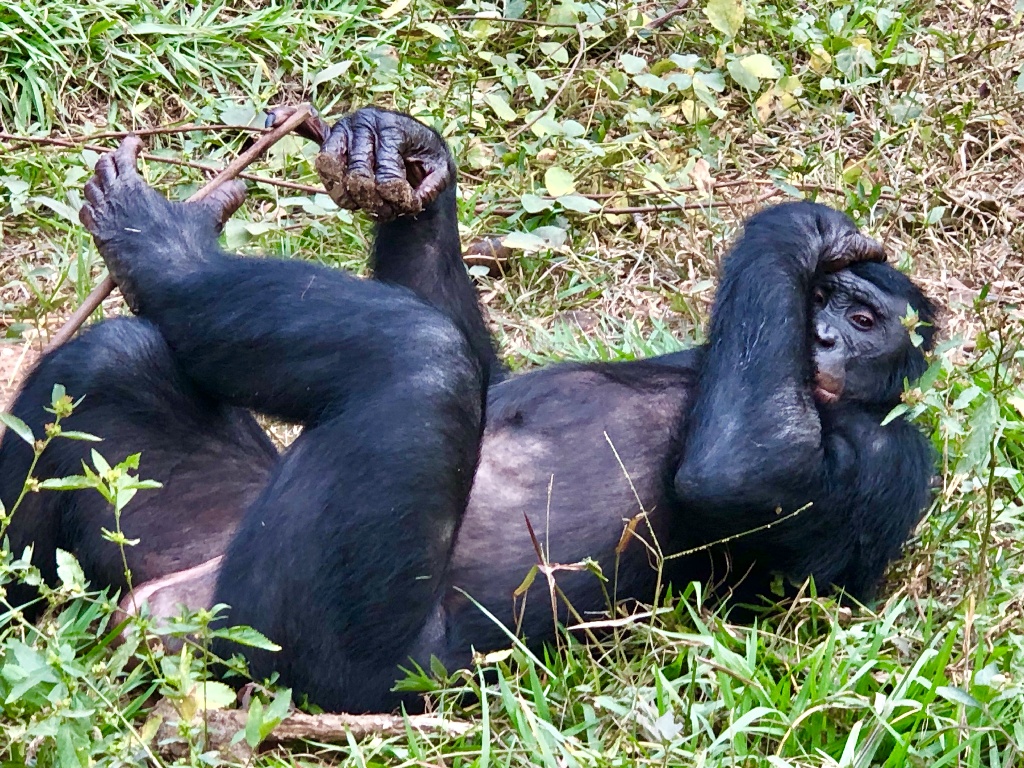



All in all we spent about an hour at the park and then it was the long trek back to town. My arse was sore from all the sitting, but at least we had AC. I enjoyed a Croque Monsoir sandwich (grilled ham and cheese) and pomes frites (fries) at the hotel before retiring for the night.
By the way, here’s a list of hotels in Kinshasa.
Kinshasa Fierce
The next day consisted of a nice tour of Kinshasa with Jeremie and his driver. Our first stop was the National Museum. I’m normally not a fan of museums, but this one was okay. In addition to viewing ancient African artifacts, I was shown giant bronze statues of King Leopold and a handful of other colonizer-heroes. But it was only later did I learn that statues of all these Europeans were at the museum because they’d been torn down and removed from their original, prominent locations downtown. Both my museum guide (Abel) and Jeremie told me stories of what a big deal the railroad was when it first opened here and how people were so happy. But then, contrarily, about the hands of hundreds (thousands?) of Africans that were cut off for not producing enough output. These hands were then sent back to Europe as proof that the colonizers in the DRC had a handle on the situation and were punishing dissenters. I had a hard time understanding if the colonizers were regarded as heroes or villains. They certainly brought progress to the area, but at what expense? Later, in the city’s main square, Jeremie showed me where the statues I just saw once lived, and it all made sense.

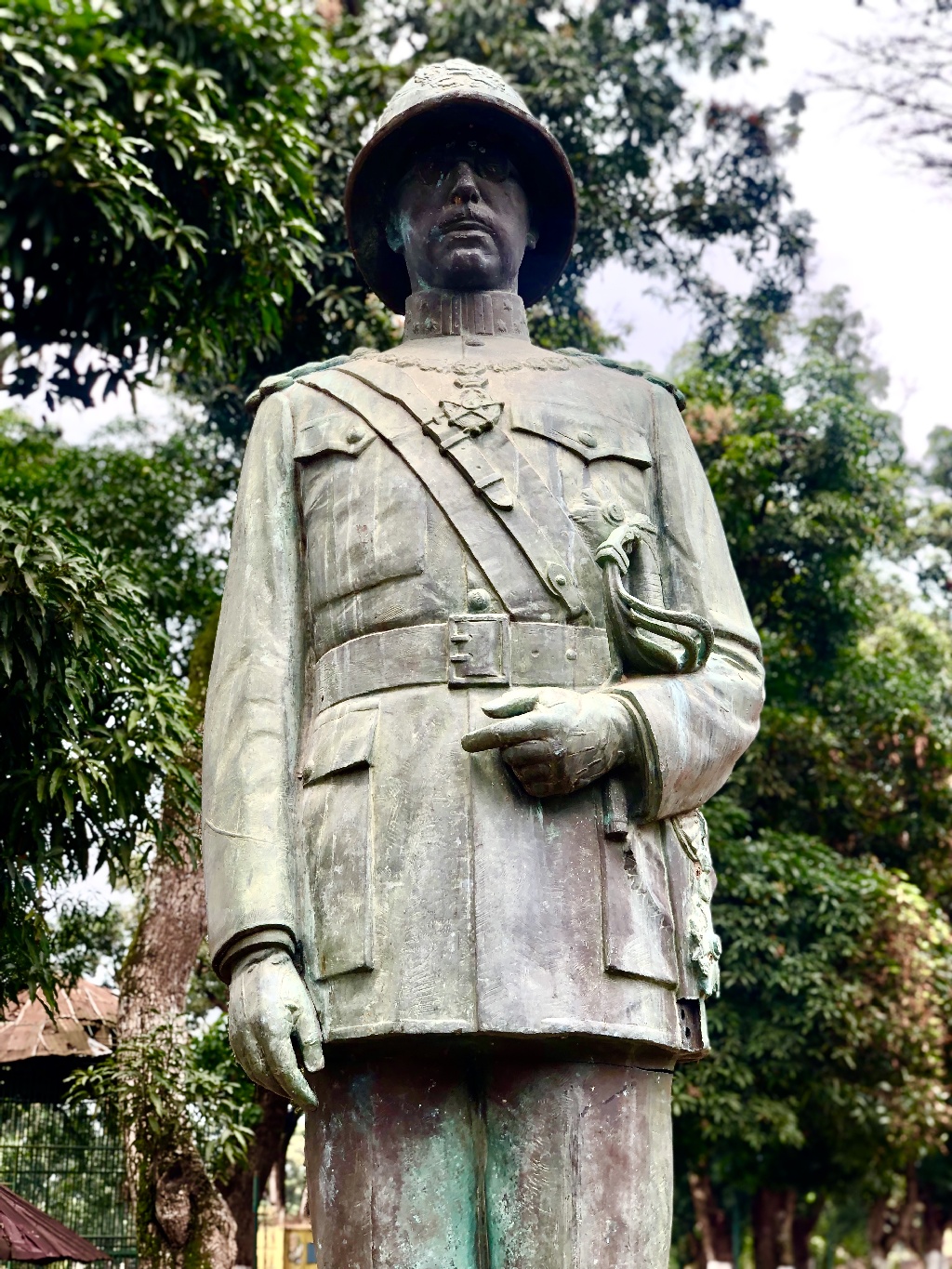


One nagging, persistent question in my mind was what happened to the railroads. Why did they not exist anymore? I passed many a railroad track obstructed by shacks and piles of junk. When did the railroads stop running, and what led up to it? Did the routes slowly die off, or did the whole system collapse at once? To confuse me even more, we next visited the old railway yard, which, in addition to housing many old, crumbling antique cars, also boasted a line of brand new rail cars. Jeremie explained that these cars were built and brought in from the Chinese, but had been just sitting here for years. I have so many questions!
*After Googling, I saw a Wikipedia article that says railroads are indeed operational. I will study up on this!


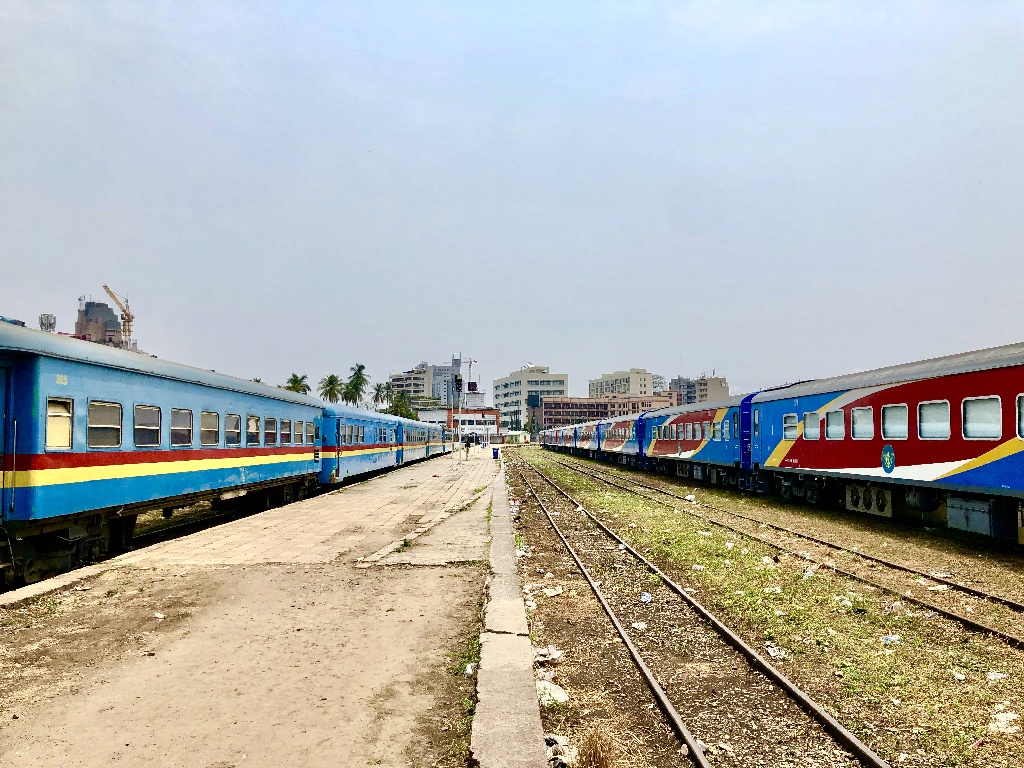
Dead Presidents
The next stops included the tomb of ex-president and national hero Laurent Kabila, who was assassinated in office back in 2001. After that, we stopped in toan art academy where students were busy working on wooden sculptures.
Our last stop was the art market, where I picked up a few souvenirs for friends and family back home, including a wooden statue by request from Dr. Laura, a famous American radio talk show host (one of my favorites!) The thirty or so vendors worked hard for my attention and I hated saying no to most of them. It looked like I was the only customer in sight, so all attention was on me. I ended up picking some up some beautiful wooden statues and some bracelets. I wished I had a huge shipping container I could’ve filled up with souvenirs, the crafts here were very special.


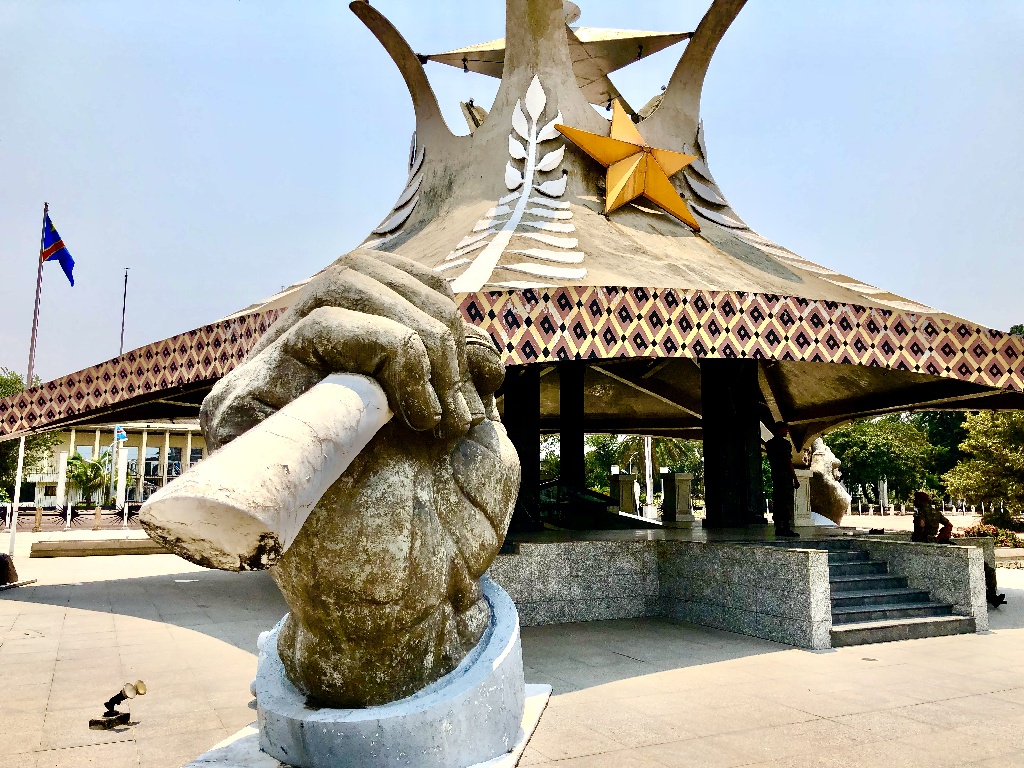

D-R-See-Ya!
I was dropped off at the hotel by 4PM and relaxed the rest of the evening, enjoying another Croque Monsoir and some French TV. My 5:20AM ride to the airport the next morning was an adventure by itself. Jeremie called a third-party cab to pick me up, and this guy sure had some driving skills. He barreled through the cratered streets of Kinshasa as the sun came up and I was surprised at how bustling the outskirts of town were so early. The streets were packed with Congolese pedestrians tighter than 5th Avenue in New York City during rush hour. These people work!!! The city was bursting alive!
And NOW…the REST of the (Insta)Story:



